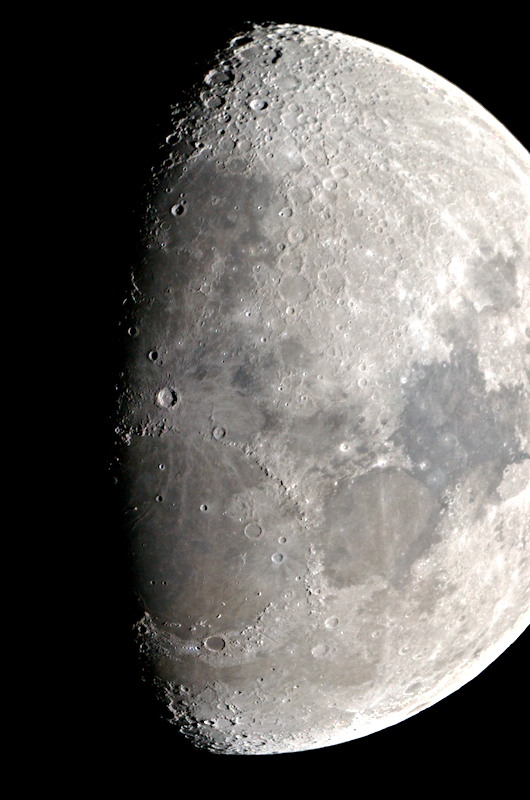
Crater Copernicus, ISS
Posted: 1 May 2012
Cassiopeia Observatory was opened Monday, 30 April, at 1811 MST, 94°F. The primary goal for this night was to image the ISS. After opening the observatory, I spent some time experimenting with possible iPad shelf designs and placement. I decided on a design and location that will be multi-functional. I plan to start construction later this week.
I powered on the 8" LX200-ACF at 1828 MST. First viewed Venus at 77X; nice crescent phase. Then went to the moon, just past First Quarter. The Crater Copernicus looked good this night. I would do some high magnification imaging of it after sunset. I next updated the ISS TLE for the telescope.
At 1907 MST, a few minutes after sunset, I viewed Copernicus at 727X (about twice the theoretical maximum magnification for an 8" telescope). The seeing was excellent and the view was really great. I then set up for D7000 DSLR prime focus imaging. This is the moon, concentrating on the terminator, 1/320sec, ISO 500:

And the Crater Copernicus, eyepiece projection at 222X, 1/250sec, ISO 4000. The cropped image was processed in Neat Image to reduce noise from the high ISO setting.

I ended lunar imaging at 1949 MST and began a visual tour of the terminator using the magnification of 727X. Great views. I next tried a magnification of 1091X, which provided an incredible view of the Crater Copernicus. I then backed off the magnification to 619X; that provided amazingly detailed views of the moon. The views of the craters Copernicus and Clavius were awesome.
At 1958 MST, I began preparing for this night's ISS pass. Mounted the D7000 at prime focus of the 8" telescope, did a focus test on the moon, did a finderscope alignment check on Venus, and did a test HD video, 1/2000sec, ISO 2000 using the moon as the target. Everything was ready at 2006 MST for the ISS pass to begin at 2026 MST.
AOS pointing was good this night and tracking was nearly perfect. However, the pass was low along the western horizon, meaning that the line-of-sight distance to the ISS was very long from my location and there was more atmosphere for its light to get through. Passes that cross near the zenith will have the line-of-sight distance to the station much shorter. This cropped frame from the HD video shows (blurrily) the station with the solar panels on both sides:

Compare the view above to that captured during the previous night's ISS pass when the station passed nearly overhead. The scale is the same on both. Quite a lot of difference.
At 2038 MST, I took a quick look at Saturn and then Mars, 77X.
Closed the observatory at 2050 MST, 70°F.
Comments are welcome; use the Comments section below, or you can Email Me. Thanks.
Go to the previous report.
Return to the Cassiopeia Observatory Welcome Page.